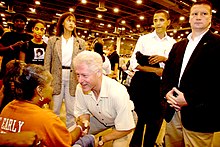Caption?
Plot Summary
A young man grows up in the mob and works very hard to advance himself through the ranks. He enjoys his life of money and luxury, but is oblivious to the horror that he causes. A drug addiction and a few mistakes ultimately unravel his climb to the top. Based on the book “Wiseguy” by Nicholas Pileggi.
As the first baby boomer president, Clinton was the first president in more than half a century not to have been alive during World War II.[185] Authors Martin Walker and Bob Woodward state Clinton’s innovative use of sound bite-ready dialogue, personal charisma, and public perception-oriented campaigning was a major factor in his high public approval ratings.[186][187] When Clinton played the saxophone on The Arsenio Hall Show, he was described by some religious conservatives as “the MTV president”.[188] Opponents sometimes referred to him as “Slick Willie”, a nickname which was first applied to him in 1980 by Pine Bluff Commercial journalist Paul Greenberg;[189] Greenberg believed that Clinton was abandoning the progressive policies of previous Arkansas Governors such as Winthrop Rockefeller, Dale Bumpers and David Pryor.[189] The claim “Slick Willie” would last throughout his presidency.[190] Standing at a height of 6 ft 2 in (1.88 m), Clinton is tied with five others as the fourth-tallest president in the nation’s history.[191][192] His folksy manner led him to be nicknamed Bubba, especially in the South.[193] Since 2000, he has frequently been referred to as “The Big Dog” or “Big Dog”.[194][195] His prominent role in campaigning for President Obama during the 2012 presidential election and his widely publicized speech at the 2012 Democratic National Convention, where he officially nominated Obama and criticized Republican nominee Mitt Romney and Republican policies in detail, earned him the nickname “Explainer-in-Chief”.[196][197]
Clinton drew strong support from the African American community and made improving race relations a major theme of his presidency.[198] In 1998, Nobel laureate Toni Morrison called Clinton “the first Black president”, saying, “Clinton displays almost every trope of blackness: single-parent household, born poor, working-class, saxophone-playing, McDonald’s-and-junk-food-loving boy from Arkansas”.[199] Noting that Clinton’s sex life was scrutinized more than his career accomplishments, Morrison compared this to the stereotyping and double standards that blacks typically endure,[199] although many viewed this comparison as unfair and disparaging to both Clinton and the African-American community at large.[200]
Shortly after he took office, conservative newspaper owner Richard Mellon Scaife organized a fundraising campaign to smear Clinton’s image in the media.[201] Leading the Arkansas Project, Scaife and other associates sought to find sources in Clinton’s home state of Arkansas who would be willing to dish out negative allegations against the President.[201]
In 1994, Paula Jones brought a sexual harassment lawsuit against Clinton, claiming he made unwanted advances in 1991, which he denied. In April 1998, the case was initially dismissed by Judge Susan Webber Wright as lacking legal merit.[202] But Jones appealed Webber Wright’s ruling, and her suit gained traction following Clinton’s admission to having an affair with Monica Lewinsky in August 1998.[203] In 1998, lawyers for Paula Jones released court documents contending a pattern of sexual harassment by Clinton when he was governor of Arkansas. Robert S. Bennett, Clinton’s main lawyer for the case, called the filing “a pack of lies” and “an organized campaign to smear the President of the United States” funded by Clinton’s political enemies.[204] Clinton later agreed to an out-of-court settlement, paying $850,000.[205] Bennett said that the President made the settlement only so he could end the lawsuit for good and move on with his life.[206] During the deposition for the Jones lawsuit, which was held at the White House,[207] Clinton denied having sexual relations with Monica Lewinsky – a denial that became the basis for an impeachment charge of perjury.[208]
In 1992, Gennifer Flowers stated that she had a relationship with Clinton that began in 1980.[209] Flowers at first denied that she had an affair with Clinton, but later changed her story.[210][211] After Clinton at first denied having a relationship with Flowers on 60 Minutes, he later admitted that he had a sexual encounter with Flowers.[212]
In 1998, Kathleen Willey alleged that Clinton groped her in a hallway in 1993. An independent counsel determined Willey gave “false information” to the FBI, inconsistent with sworn testimony related to the Jones allegation.[213] On March 19, 1998, Julie Hiatt Steele, a friend of Willey, released an affidavit, accusing the former White House aide of asking her to lie to corroborate Ms. Willey’s account of being sexually groped by President Clinton in the Oval Office.[214] An attempt by Kenneth Starr to prosecute Steele for making false statements and obstructing justice ended in a mistrial and Starr declined to seek a retrial after Steele sought an investigation against the former Independent Counsel for prosecutorial misconduct.[215] Linda Tripp‘s grand jury testimony also differed from Willey’s claims regarding inappropriate sexual advances.[216]
Also in 1998, Juanita Broaddrick alleged that Clinton had raped her in the spring of 1978, although she stated she did not remember the exact date.[217] In another 1998 event, Elizabeth Gracen recanted a six-year-old denial and stated she had a one-night stand with Clinton in 1982.[218] Gracen later apologized to Hillary Clinton.[219] Throughout the year, however, Gracen eluded a subpoena from Kenneth Starr to testify her claim in court.[220]


























